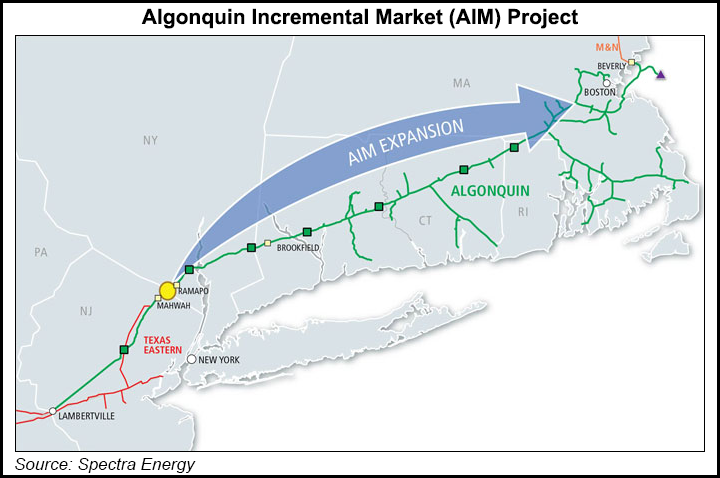Regulatory | Infrastructure | NGI All News Access
FERC Denies New York’s Request to Suspend AIM Project
FERC said it will not order a halt to construction of the Algonquin Incremental Market (AIM) pipeline project while four regulatory agencies in New York state investigate a troubled nuclear power plant adjacent to the pipeline’s route.

In an order Friday, the Federal Energy Regulatory Commission said it concurred with the U.S. Nuclear Regulatory Commission (NRC) that the AIM Project “will not result in increased safety impacts” at Entergy Corp.’s Indian Point Energy Center (IPEC). The NRC reviewed an analysis conducted by Entergy, which concluded that the pipeline — as proposed and with certain safety mitigation measures — would not increase risks to the IPEC or reduce the margin of safety. The NRC also performed its own analysis of the project and reached the same conclusion.
FERC gave authorization [CP14-96] for Spectra Energy Partners LP’s Algonquin Gas Transmission LLC to begin construction of the 342,000 Dth/d pipeline in March 2015 (see Daily GPI, March 4, 2015). But nearly one year later, the administration of New York Gov. Andrew Cuomo asked FERC to reconsider and stay its authorization until four state agencies were finished with their investigations at the IPEC. The facility is located in Buchanan, NY, in Westchester County, and sits along the east bank of the Hudson River (see Daily GPI, March 1).
Spectra has pledged to build the pipeline to more stringent standards on the IPEC grounds. Those mitigation measures include laying two concrete liners above the pipeline, burying the pipeline deeper than the company is required to do so, and using a stronger grade of steel than what is required.
According to state officials, incidents at the IPEC include a leaking steam generator, electrical problems, improperly inserted control roads and a fire within a transformer. The latest, and most serious, incident occurred on Feb. 6, when a radioactive tritium leak at the plant caused groundwater radioactivity levels to increase more than 65,000%.
But FERC said all of the incidents occurred within the IPEC’s security barrier, which lies at least 2,370 feet from the pipeline. The agency added that the horizontal directional drilling necessary to run the pipeline under the adjacent Hudson River is more than twice the distance from the barrier.
The four state agencies investigating the incidents at the IPEC are the Department of Homeland Security and Emergency Services, the Department of Environmental Conservation (DEC), the Department of Health and the Department of Public Service.
“There is nothing in the DEC’s current pleading that calls our findings regarding the safety of constructing a portion of the AIM Project in the vicinity of the IPEC facility into question,” wrote FERC Deputy Secretary Nathaniel J. Davis Sr. “Therefore, we find no basis for granting the requested reconsideration.”
In a separate order on Friday, FERC issued a notice to proceed with construction of AIM Project facilities in Southeast, NY, and Danbury, CT. Specifically, Algonquin was given permission “to construct the remaining pipeline sections of the Southeast to MLV 19 Take-up and Relay from Station 0+00 to 49+00, Station 113+82.8 to 204+09.6, and Station 223+82.5 to 233+95.3.”
The AIM pipeline will transport natural gas produced in the Marcellus and Utica shales from Ramapo, NY, to citygates in Connecticut, Rhode Island and Massachusetts. It is expected to be in service during the second half of 2016.
© 2024 Natural Gas Intelligence. All rights reserved.
ISSN © 1532-1231 | ISSN © 2577-9877 |
